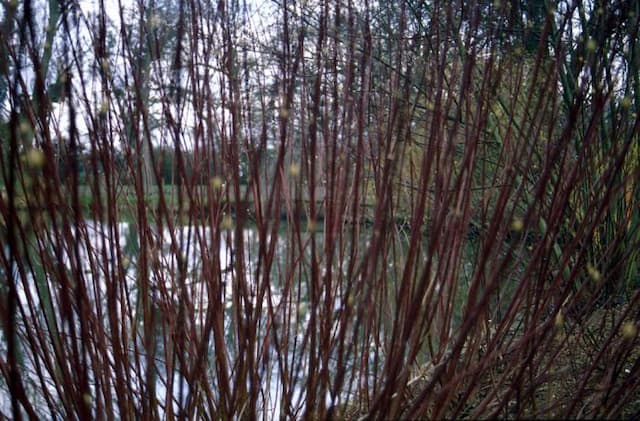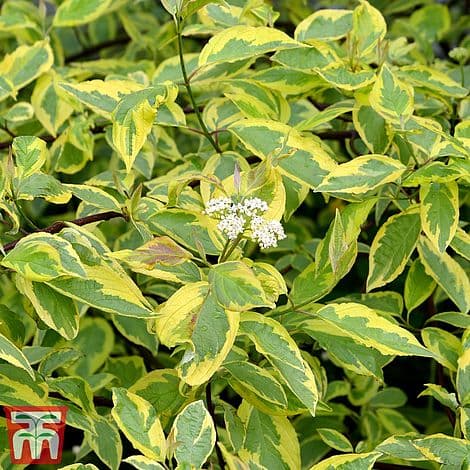Kousa Dogwood Cornus kousa 'Greensleeves'
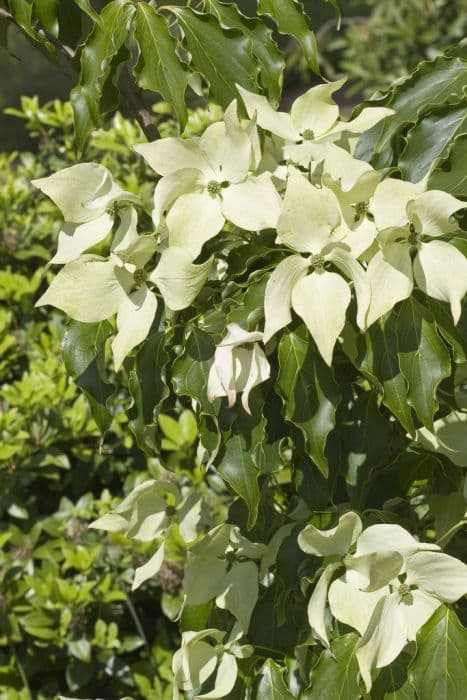


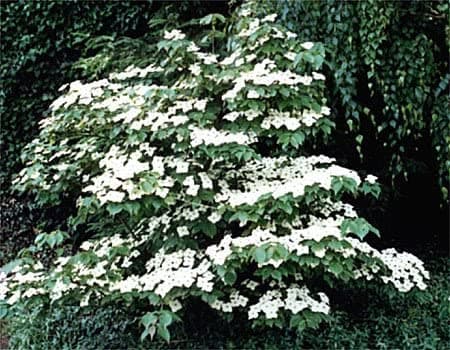
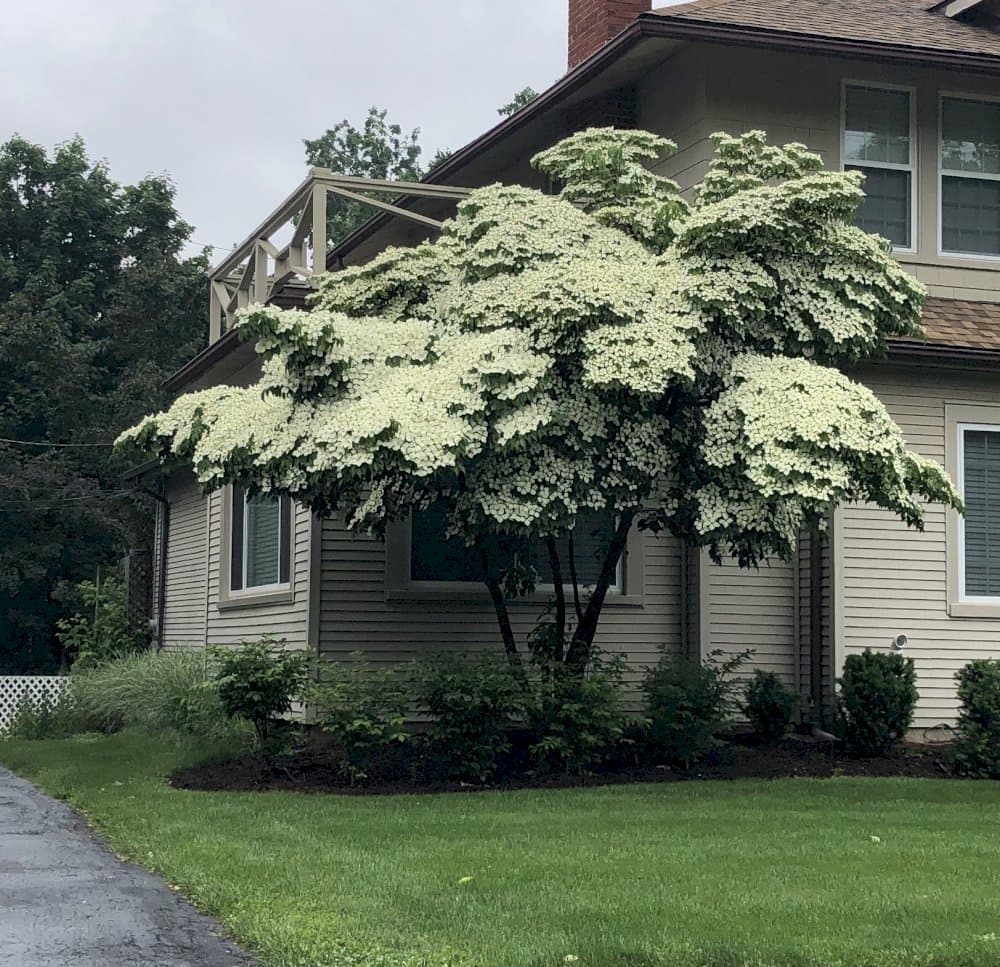
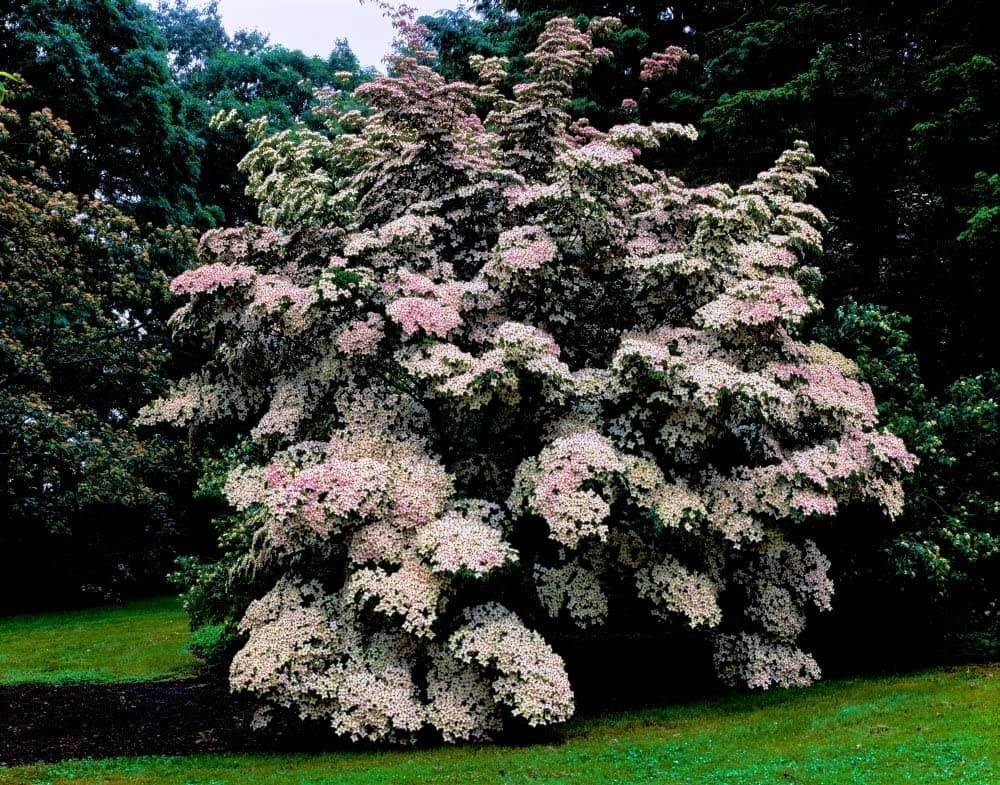
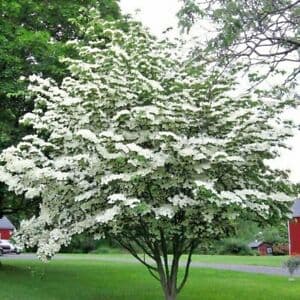
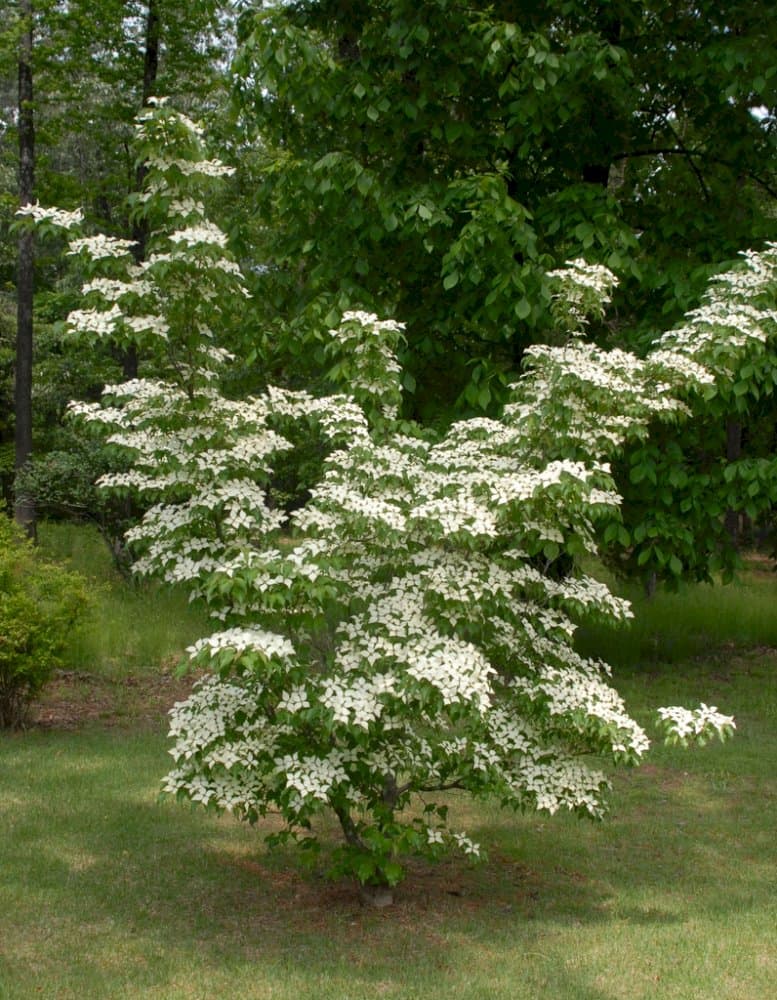
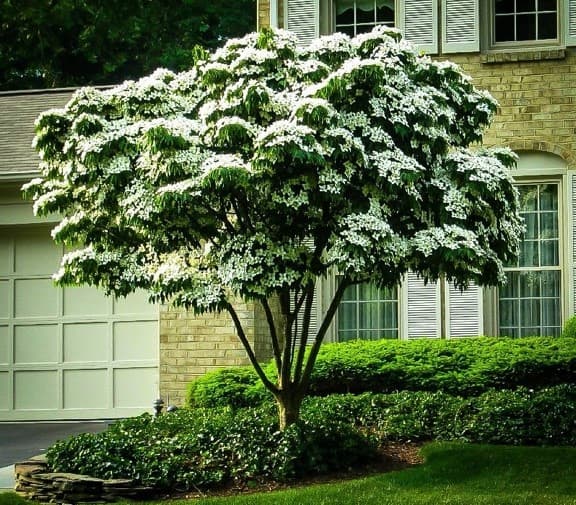
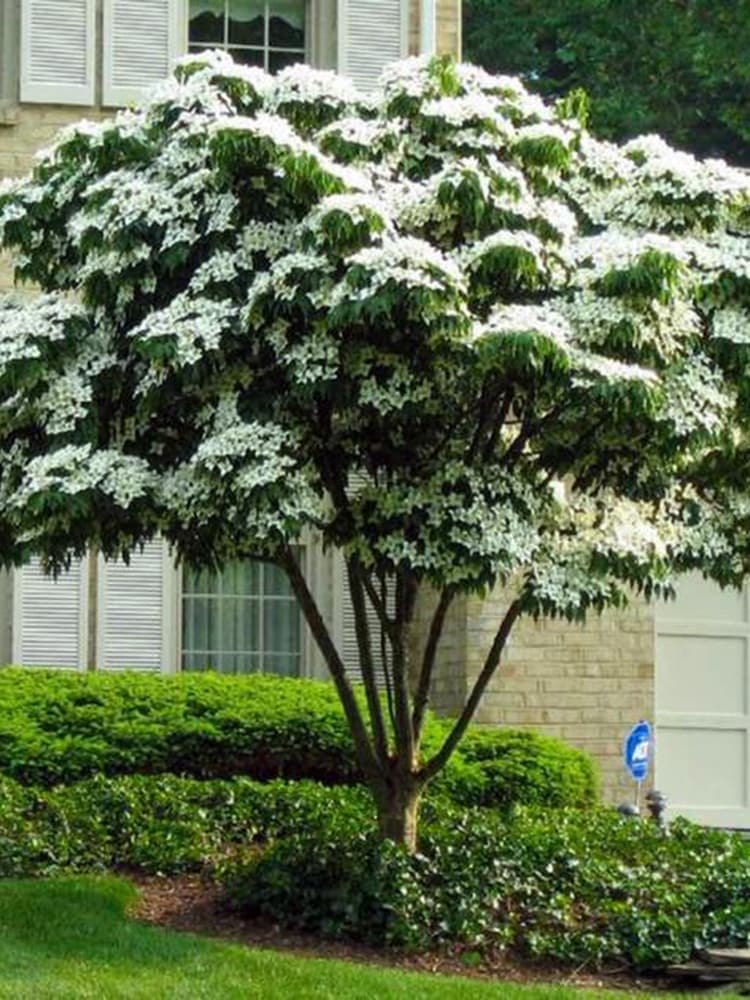
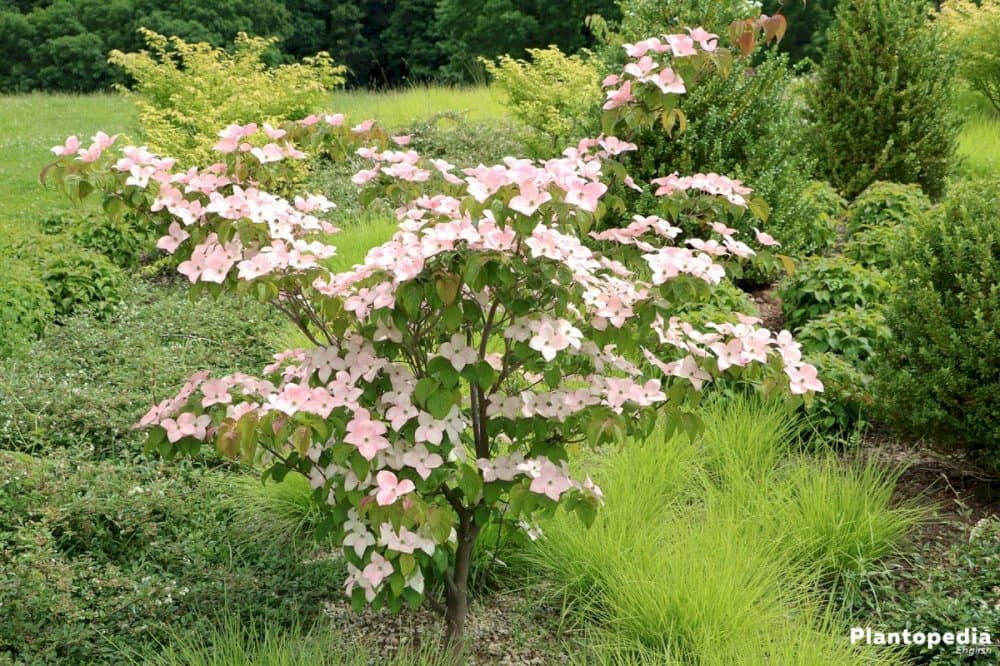
ABOUT
The Cornus kousa 'Greensleeves', commonly known as Kousa dogwood, is a visually striking ornamental tree renowned for its seasonal beauty. In spring, it becomes a focal point in the landscape with its profusion of greenish-white, star-shaped flowers that are actually bracts, which are modified leaves surrounding the tiny, inconspicuous true flowers in the center. As summer progresses, the bracts gradually turn a creamy white. The foliage of the Greensleeves Kousa dogwood has a distinctive appearance. The leaves have a broad, elliptic shape with pointed tips, and are noted for their lustrous, medium to dark green color. With the changing seasons, the leaves transform, taking on striking autumn hues with variegations of red and purple, which adds another layer of interest to this multi-season tree. In late summer to early autumn, the plant produces round fruit that resembles berries. These are initially a greenish color and ripen to a pinkish-red hue. The texture of the fruit is somewhat bumpy and the flesh is edible, though it is not widely consumed due to its sometimes mealy texture and unique, not universally appealing taste. The bark of the Kousa dogwood is another notable feature. It exfoliates with age, creating an appealing mottled pattern of tan, gray, and brown layers, providing winter interest when the leaves have fallen. Overall, the Kousa dogwood 'Greensleeves' provides year-round ornamental value, making it a cherished element in gardens and landscapes.
About this plant
 Names
NamesSynonyms
Kousa Dogwood, Korean Dogwood, Chinese Dogwood, Japanese Dogwood, Kousa.
Common names
Cornus kousa 'Greensleeves'.
 Toxicity
ToxicityTo humans
The Kousa dogwood (Cornus kousa 'Greensleeves') is generally considered non-toxic to humans. As far as common knowledge goes, there are no notable toxins present in the plant that would cause poisoning if ingested. In fact, the fruit of the Kousa dogwood is edible and sometimes used for making wine or jelly. However, it's important to note that while the berries might be edible when ripe, other parts of the plant, such as leaves and bark, are not typically consumed, and eating them could potentially cause minor stomach upset due to the presence of tannins or other plant compounds not intended for human digestion.
To pets
The Kousa dogwood (Cornus kousa 'Greensleeves') is also generally considered non-toxic to pets. It does not contain any known toxins that would harm dogs or cats if they were to ingest parts of the plant. The fruit of the Kousa dogwood is even edible for pets, although it's not commonly used as a food source for them. Of course, as with any non-food plant, ingestion of large amounts could potentially lead to gastrointestinal upset in sensitive pets, so it is advisable to prevent your pets from consuming large quantities of the plant. However, in terms of toxicity, Kousa dogwood does not pose a significant threat to the health of pets.
 Characteristics
CharacteristicsLife cycle
Perennials
Foliage type
Deciduous
Color of leaves
Green
Flower color
White
Height
15-30 feet (4.6-9.1 meters)
Spread
15-30 feet (4.6-9.1 meters)
Plant type
Tree
Hardiness zones
5-8
Native area
Asia
Benefits
 General Benefits
General Benefits- Ornamental Appeal: Features showy white flowers in late spring and early summer, adding visual interest to gardens.
- Seasonal Interest: Produces strawberry-like fruit in the fall and vibrant red to purple leaf color, offering multi-seasonal appeal.
- Drought Tolerance: Once established, it is relatively drought-resistant, reducing the need for frequent watering.
- Pest Resistance: Generally resistant to many common pests, minimizing the need for chemical treatments.
- Wildlife Attraction: Berries provide a food source for birds, supporting local biodiversity.
- Low Maintenance: Requires minimal pruning and care once established, making it suitable for low-maintenance landscapes.
- Tolerance to Shade: Can grow in partial shade, providing flexibility in garden design and placement.
- Cold Hardy: Able to withstand cold temperatures, making it suitable for a variety of climates.
 Medical Properties
Medical PropertiesThis plant is not used for medical purposes.
 Air-purifying Qualities
Air-purifying QualitiesThis plant is not specifically known for air purifying qualities.
 Other Uses
Other Uses- Culinary Ingredient: The fruit of Cornus kousa can be eaten raw or used in recipes such as jams, jellies, and desserts due to its sweet and unique flavor.
- Dye Production: The bark and leaves of the plant can be used to produce dyes for textile coloring, providing a natural alternative for artisans.
- Craft Material: The wood is hard and can be carved into small objects or used in turning projects for making items like tool handles or intricate wooden crafts.
- Photography and Painting Subjects: Due to its beautiful and distinct flowers, Cornus kousa ‘Greensleeves’ is often used as a subject for botanical photography and paintings.
- Summer Shade Provider: When grown in gardens and parks, the plant offers shade during the hot summer months due to its dense foliage.
- Windbreak: In landscaping, rows of Cornus kousa can be planted to act as a windbreak, protecting smaller plants from strong winds.
- Wildlife Shelter: The dense branches and foliage provide shelter and nesting sites for birds and small mammals within garden ecosystems.
- Erosion Control: With its extensive root system, Cornus kousa can be used in sloped areas to help prevent soil erosion and runoff.
- Seasonal Decoration: During autumn, the leaves turn vibrant colors, and the tree can be used as a part of seasonal decorations in landscapes.
- Festive Ornamentation: Branches with berries and flowers can be cut and used in floral arrangements or festive decorations during various celebrations.
Interesting Facts
 Feng Shui
Feng ShuiThe Kousa dogwood is not used in Feng Shui practice.
 Zodiac Sign Compitability
Zodiac Sign CompitabilityThe Kousa dogwood is not used in astrology practice.
 Plant Symbolism
Plant Symbolism- Protection: Cornus kousa 'Greensleeves', commonly known as Kousa dogwood, is often associated with protection due to its sturdy nature and the way its canopy spreads wide, providing shelter.
- Endurance: The Kousa dogwood's ability to withstand various climates and resist many diseases symbolizes strength and endurance through challenging conditions.
- Renewal: As a flowering tree that blooms with beautiful white to pink flowers in the spring, the Kousa dogwood represents the theme of renewal and the beauty that follows a harsh winter.
- Innocence: The pristine, white flowers of the Kousa dogwood are commonly associated with purity and innocence.
- Christian symbolism: In Christian symbolism, the dogwood's characteristic cross-shaped flowers are said to represent the crucifixion of Jesus, making the tree a symbol of faith and Christ's sacrifice.
 Water
WaterKousa dogwood should be watered deeply once a week, providing about 1 to 1.5 inches of water, which equates to approximately 5 to 10 gallons for a young tree, depending on soil type and weather conditions. During hot, dry periods, you may need to water twice weekly, while in cool, moist climates or seasons, watering frequency may be reduced. It's essential to avoid overwatering as Kousa dogwoods are sensitive to wet feet, so ensure the planting area has good drainage. Newly planted trees require more frequent watering until they are established, which usually means keeping the soil consistently moist for the first year.
 Light
LightKousa dogwood thrives in a spot with full sun to partial shade. Best growth and flowering are achieved with at least 4 to 6 hours of direct sunlight daily, but the plant can tolerate light shade, especially in hotter regions where some afternoon shade can protect it from intense sun.
 Temperature
TemperatureKousa dogwood prefers moderate temperatures and is hardy in USDA zones 5 through 8. It can withstand winter temperatures down to about -10 to -20 degrees Fahrenheit and summer temperatures up to 90 degrees Fahrenheit. Ideally, the Kousa dogwood enjoys a temperate climate with temperatures ranging from 60 to 75 degrees Fahrenheit.
 Pruning
PruningPruning Kousa dogwood is primarily for shaping and removing any broken, diseased, or crossing branches to improve the tree's health and appearance. The best time to prune is late winter or early spring before new growth starts. Pruning should be done sparingly as this tree naturally forms a pleasing shape, and excessive pruning can weaken the plant.
 Cleaning
CleaningAs needed
 Soil
SoilKousa dogwood prefers well-draining, fertile soil with a pH between 5.5 and 6.5. A mix containing loam, peat, and sand or perlite is ideal to provide proper nutrition and drainage.
 Repotting
RepottingKousa dogwoods are not typically grown in pots and therefore do not require repotting. They are outdoor plants best suited for planting in the ground.
 Humidity & Misting
Humidity & MistingKousa dogwood thrives in moderate humidity levels and does not require any special humidity conditions, making it a versatile plant in various outdoor environments.
 Suitable locations
Suitable locationsIndoor
Not recommended for indoor growth; needs full sun to partial shade.
Outdoor
Plant in well-drained soil, full sun or partial shade, and mulch.
Hardiness zone
5-8 USDA
 Life cycle
Life cycleThe Kousa Dogwood 'Greensleeves' begins its life as a seed, which after stratification (a period of cold to break dormancy), germinates in spring to produce a seedling. As the seedling grows, it develops a root system and shoots that lead to the formation of a sapling with characteristic opposite leaves and a vase-shaped growth habit. Throughout the spring and early summer, the sapling matures into a flowering tree, with the 'Greensleeves' variety producing greenish-white, pointed bracts around small, inconspicuous flowers, followed by the development of pinkish-red berry-like fruits. Over the years, the tree continues to grow, reaching up to 15-30 feet in height, and develops a distinctive, exfoliating bark and a canopy that provides shade and ornamental value. The plant reaches maturity and enters a period of reproduction, where flowers are pollinated by insects, leading to fruit production that attracts birds, which in turn disperse the seeds, completing the reproductive cycle. The Kousa Dogwood 'Greensleeves' can live for several decades, offering seasonal interest with its spring flowers, summer fruit, and vibrant autumn foliage.
 Propogation
PropogationPropogation time
Late winter-early spring
Propogation: Cornus kousa 'Greensleeves', commonly known as the Kousa dogwood, is best propagated through semi-hardwood cuttings taken in midsummer. Choose a healthy, disease-free branch and cut a 4 to 6-inch (10 to 15 cm) section, making sure there are at least two sets of leaves on the cutting. The bottom set of leaves should be removed, and the cut end dipped in rooting hormone to encourage root development. The cutting should then be placed in a well-draining potting mix, with the cut end buried 1 to 2 inches (2.5 to 5 cm) deep. The cutting needs a warm, humid environment to root, which can be achieved by covering it with a plastic bag or placing it in a propagator. It’s important to keep the soil moist but not waterlogged and to provide indirect light until roots have established, which typically takes several weeks. Once rooted, the new Kousa dogwood can be transplanted to a larger container or directly into the garden.
